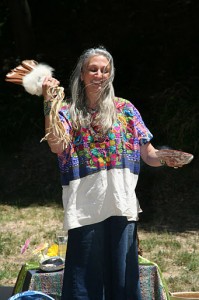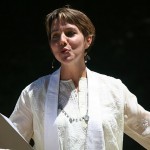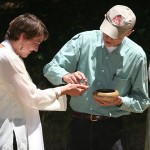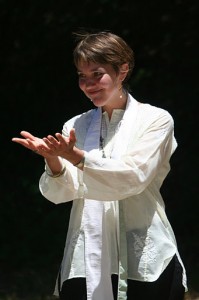A few weeks ago I sat with Bob, Elaine and Hanna to talk with them about this day. I asked them what they were hoping to have conveyed in this segment of the service, and one of them said, “In a nutshell, Lauren, we want you to explain ‘why we are here and what we are doing.’”
GRAND questions! Why are we here? What are we doing?
First, Why are we here? I have three ideas:
- For starters, as family and friends who love you, we’re here to honor and celebrate your sense of clarity. Any person who comes to know his/her Right Work in this world deserves, at a minimum, recognition and more appropriately still, a ritual to proclaim it and to bless your way forward.
- As a spiritual community, we’re here to honor the practice of Interfaith. I’m using the word, “practice,” very intentionally, because the word, Interfaith and how it is defined carries multiple truths for many people. As a community, we’re here both to engage with and to celebrate the dynamic tension and stimulus invited through our Interfaith practice.
- Also, as individuals within the greater human family, I will boldly suggest we’re here because within each of us, there is a hunger or desire for things to be other than they are; for the Big Picture to look and feel different.
A day ago, I fell into a conversation with a handful of women I barely know. We were reflecting on a local news headline that had us all distressed. Sighing softly and – I thought – inaudibly, I uttered, “We need to do something different.” The woman across from me, put her hands to her chest, “Oh my gosh; that’s it! We need to do something different.” And this segues into the next question…what are we doing?
In Sanskrit, there is a phrase, “Neti; Neti.” Translated, it means, “Not this; neither that.” When something isn’t this…and it isn’t that, what remains? This question actively informs our studies at The Chaplaincy Institute, and our spiritual practices as an Interfaith Congregation. As a first step, we endeavor to better understand the “this” and the “that,” in their unique wholeness. For example, we study the core teachings of Christianity, and the core teachings of Sikhism. We strive to appreciate the light and the shadow imbedded in all the Wisdom Traditions. And then, as Interfaith Ministers or Chaplains, we venture on, a little further. Valuing the completeness of two ideas, what happens when we actively lean into the space that’s in-between?
We all have experience with this concept; most commonly, it appears when we try to resolve a conflict, but it also shows up when humans are trying to do something different. The work of interfaith ministry is not only about this, nor only about that, but about tending the possibility, as it arises.
I won’t lie: this work is DICEY. Doing something “different,” means living unrehearsed. It means responding to uncertainty; it means speaking truth when the stakes are high; it means searching for justice and embodying peace, it means sitting with others and allowing our powerlessness — our inability to fix painful situations — to be the offering of suffice. Is this work reserved for clergy? Heck, no! In these times, it’s all hands on-deck. On behalf of all species, the human family world-around; our resources, businesses, cultures and support systems all in flux and varying states of innovation and break-down, we are ALL being invited to engage in this practice. AND, we need support.
And, this is why we’re here and what we’re doing. Today, Bob, Elaine and Hanna are heeding a deep sense of Call. Responding to their faithful belief, their trust in the Divine, they are offering themselves as resources of support. In co-creative practice with the Divine, these three are signing-on to companion and witness the rest of us in the holy, unpredictable patterns of life and death, joy and sorrow, coming and going, growing and grieving.
And on this day, the Interfaith Congregation is both celebrating your Call and recognizing your accomplishments. Your studies have strengthened you to do this work as authentically as each of you – Bob, Hanna and Elaine – can vulnerably-bravely-resiliently-wisely-and-compassionately muster.
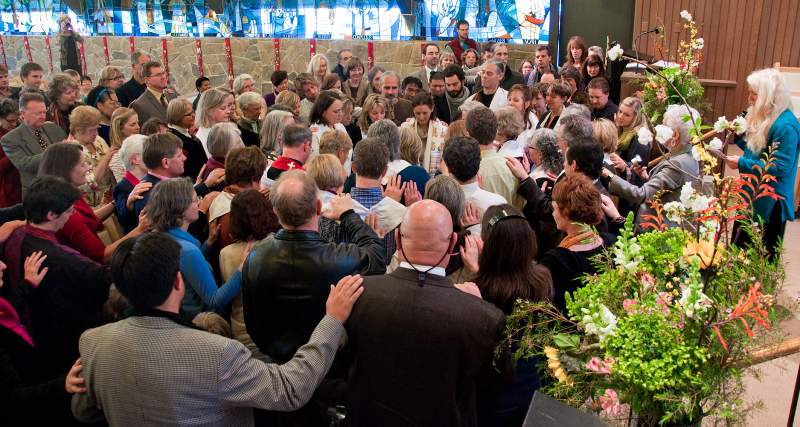
March 2011 Ordination, Laying-On of Hands. Photo: V. Weiland
Each of us, responding to our hunger for greater connectivity, more intimacy, deeper understanding has arrived here today to bless your way forward. Thank you for your courage; thank you for saying “Yes!;” thank you for inspiring the rest of us to ask if there’s, perhaps, something out there that might just be refreshingly, soothingly, soul-shiftingly different.
To close, I bless you with the words of Rumi and his poem, Always You:
First when I was apart from You, this world did not exist, nor any other.
Second, whatever I was looking for was always You.
Third, why did I ever learn to count to three?
